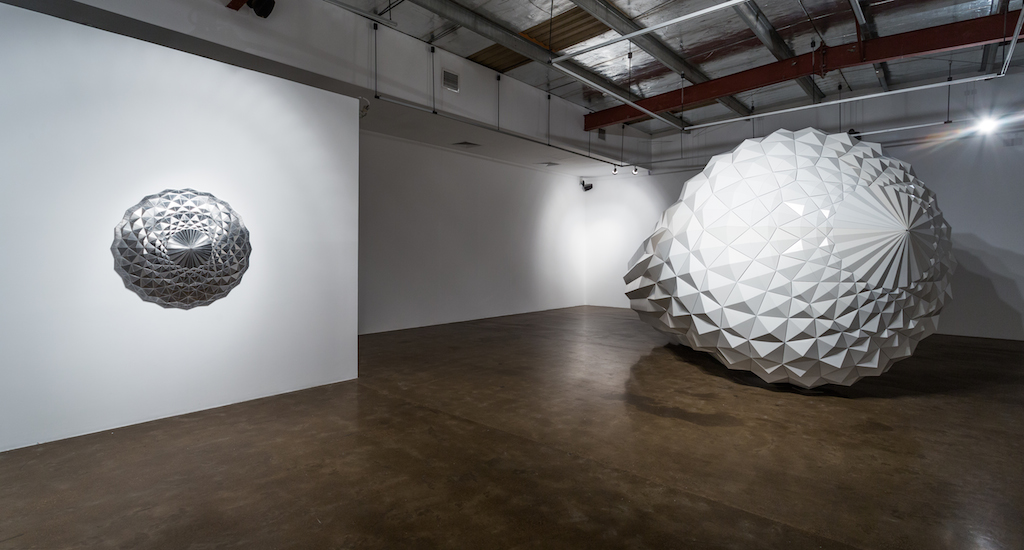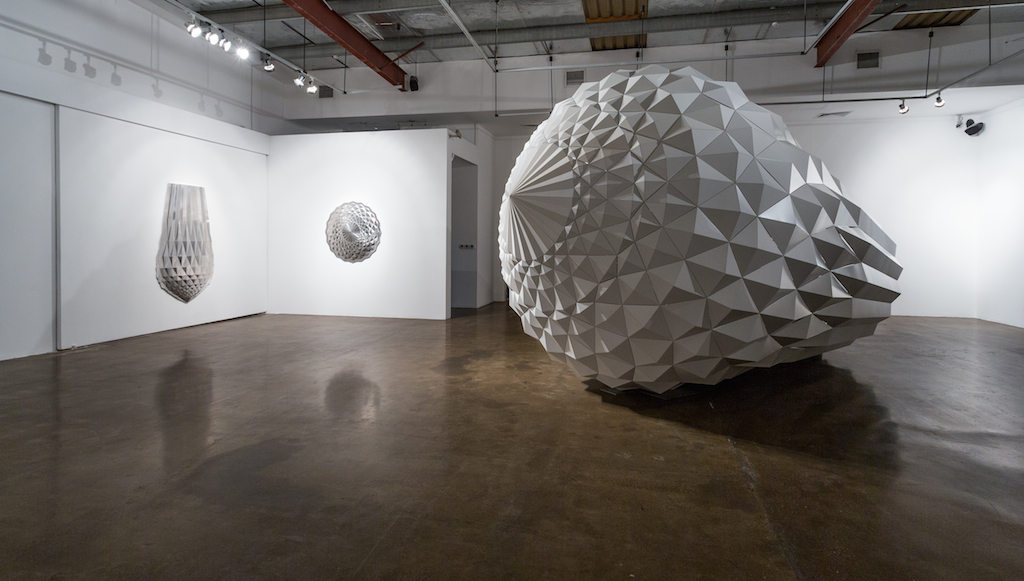Sahand Hesamiyan’s Khalvat (2014) resembles a futuristic vessel. Composed of a circular shell, the thin ribs that begin at the work’s oculus create a sense of propulsion as they extend into narrow piers. With triangular pieces adjoined to its lattice frame at forty-five degree angles, the projectile sculpture appears to spin in space, defying the spatial and temporal limitations of a stationary object.
In several recent works, Hesamiyan selects an element of Islamic architecture then reconfigures its traditional design in order to broaden its function—a process that allows him to identify the conceptual potential of a given motif. Khalvat represents a ‘hidden, private sanctum’ in the shape of a Rasmi dome, a feature that is found in both secular buildings and places of worship. Examples of the vault are commonly used in public spaces such as mosques and bazaars, and include elaborate star patterns that adhere to the concepts of unity and beauty, the bases of Islamic aesthetics. These principles are derived from the tenets of Islam, particularly the belief that God is absolute, boundless and timeless, and that all things result from divine will. Relying on an extensive system of symbols, many facets of Islamic architecture describe the metaphysical order that is thought to govern the cosmos. Symmetry, proportion, and spatial organization intend to heighten awareness through perception, inspiring the occupant to recognize the oneness of God. An emphasis on aestheticized forms arises from the view that beauty is a product of divine creation and should be expressed as a sign of piety.
The distinguishing characteristic of a Rasmi dome is its complex design. Expanding from the circle at its focal point, the vault envelops the immediate space below with a spectacular geometric scheme, establishing an interior within an interior where the atmosphere is vertically defined. The circle is the archetypal image of unity in Islamic art, and the primary source from which its exponential patterns are constructed, a use of mathematics that symbolizes God as the sustaining force of the material world although transcendent. The starburst ceiling of a Rasmi dome is assembled using advanced engineering and provides a three-dimensional representation of infinite creation.
In Khalvat, Hesamiyan has set a prototype of the dome on a lengthened drum and placed the structure on its side, shifting its orientation. The area of the drum gradually decreases towards the base of the sculpture, adding to the enclosed shape of the work. Adopting the Sufi theory of purification, which advocates the annihilation of the ego in order to reach an enlightened state, the artist strips away the verbose infilling of the Rasmi form in order to uncover its implied mysticism. A core value of Sufism is the search for Truth or ‘the unity of being,’ a higher consciousness achieved through mindful action. Khalvat demonstrates a similar path. Isolating its fundamental components, the artist offers a new sanctum, one also receptive to the exterior world.
With the framework revealed, the armature displays a series of ridged rings. The concentric discs are held in place with ribs that meet at the apex of the work’s crown, suggesting several stages of ascension—the course taken by a Sufi when pursuing Truth. At the heart of the multipoint star that tops the convex sculpture is a small aperture. While the hole is seemingly insignificant due to its relative size, its importance lies in replicating a facet that stimulates immersion through sensory experience. In Rasmi domes, light is allowed to enter through the cavity or is otherwise simulated through ornamentation, signifying a heavenly presence. By eliminating the decorative garnishing, the circle is shown as the point of origin for the system of lines that constitute the skeleton of the vault. Without the intricate detailing that is typically added to the inner surface of the dome through masonry, mosaics, or tilework, the artist gives equal importance to negative space and frees its center. The resultant openings filter light through the body of the sculpture, illuminating the inside portion as ethereal shadows are cast onto its surroundings.
 [Installation view of Khalvat (2014). Image copyright the artist. Courtesy of The Third Line gallery, Dubai.]
[Installation view of Khalvat (2014). Image copyright the artist. Courtesy of The Third Line gallery, Dubai.]
Hesamiyan positions the Rasmi structure as an embodiment of the introversion of Iran’s built environment. Conventional plans place an emphasis on the ‘hidden architecture’ of interiors, leading to a notable contrast between the inner and outer parts of a building. In keeping with Islamic aesthetics, the sacred imagery of private and public spaces can only be viewed from within, an affirmation that nothing exists outside of the Absolute. Although this internal focus aims to prompt spiritual reflection, the evocative physicality of an edifice is invariably hidden beneath embellishments. In seeking to return to the basic contour of the dome, the artist’s creative adaptation of Sufism is epistemological as much as it is concerned with metaphysics, locating the role of mysticism in the historical development of Iranian culture.
The early stages of modern Persian history can be traced to the Safaviyya, a politically influential Sufi order from which the Safavid dynasty emerged in 1501. Despite the suppression of Sufi practitioners that came with the dynasty’s shifting political alliances, the influence of Sufism on the period’s theology was significant.[1] While the unification of Persia and the introduction of the Shia branch of Islam as the official religion are attributed to the Safavid era, the period concurrently witnessed the blossoming of sacred and secular architecture, initially with large-scale restoration projects that included ornamental enhancements. Later breakthroughs produced innovative structural designs and a greater inclusion of vaults, arcades, portals, and vestibules. Accompanying this growth was an intensification of decorative patterns that transformed interiors into awe-inspiring allusions to paradise. The empire’s emphasis on artisan trade led to extensive official patronage under which other art forms flourished, particularly painting, carpet weaving, and textiles. Through the progressive phases of his Rasmi dome, Hesamiyan unpacks the historical buildup that informs Iranian architecture, above all the inward disposition that continues to have an impact on the composition of urban space and, by extension, social interaction.
 [Installation view of Khalvat (2014). Image copyright the artist. Courtesy of The Third Line gallery, Dubai.]
[Installation view of Khalvat (2014). Image copyright the artist. Courtesy of The Third Line gallery, Dubai.]
Removed from the Iranian context, Khalvat retains its metaphysical undertones. Dispensing of excess materiality, asceticism is also described in stylistic terms. With its simplified form Hesamiyan’s sculpture appears to become part of a given setting, or what Richard Serra refers to as ‘the behavioral space of the viewer.’ The viewer, in turn, is prompted to reevaluate her own physical presence. As she examines the spherical work, she unconsciously rotates around the sculpture, her movement determined by the meditative act of viewing, a ritualistic dance that causes her to transcend the space.
*The above essay first appeared as the accompanying text to Sahand Hesamiyan`s recent solo exhibition, Khalvat, which is on view at The Third Line gallery in Dubai until January 31.
1. Ayman Shihadeh, ed., Sufism and Theology (Edinburgh: Edinburgh University Press, 2007).